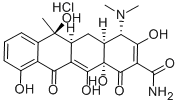b

Thank You!
Your requirement has been sent, we will contact you quickly!
Sent Failed!
Try again!
Introduction:
Tetracycline hydrochloride is a broad-spectrum antibiotic with bactericidal effect at high concentration. In addition to common gram-positive bacteria, Gram-negative bacteria and anaerobic bacteria, most of them are Rickettsia, mycoplasma, chlamydia, atypical mycobacterium, spirochete, actinomycetes, Bacillus anthracis, Listeria monocytogenes, Clostridium Nocardia is sensitive to this product. The effect of this product on Gram-positive bacteria is better than that on Gram-negative bacteria, but Enterococcus and penicillin resistant Neisseria gonorrhoeae are resistant to it. This product has good antibacterial activity against Gram-negative bacteria such as Vibrio, Brucella, Campylobacter and Yersinia, and has no antibacterial activity against Pseudomonas aeruginosa.
Physicochemical properties:
Tetracycline hydrochloride is yellow crystal and odorless. It tastes bitter. Easy to absorb moisture. When encountering light, the color gradually deepens. Soluble in water and methanol. Ethanol, insoluble in ether, hydroxyl. It is an antibacterial substance isolated from the culture medium of actinomycetes Streptococcus aureus. It has a good inhibitory effect on Gram-positive bacteria, negative bacteria, Rickettsia, filtered viruses, spirochetes and even protozoa, but has no effect on tuberculosis and Proteus.
CAS:64-75-5
Molecular formula: C22H25ClN2O8
Molecular weight: 480.9
Structural type: 
Purpose:
Tetracycline hydrochloride is an antibiotic used to treat Chlamydia infection, Rickettsia disease, mycoplasma pneumonia, relapsing fever and other non bacterial infections. It is also used for the treatment of brucellosis, cholera, rabbit fever, rat bite fever, anthrax, tetanus, plague, actinomycosis, gas gangrene and sensitive bacteria, respiratory tract, biliary tract, urinary tract infection and skin and soft tissue infection.

